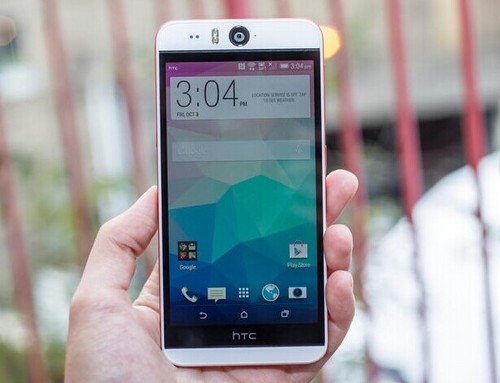The HTC Desire Eye is a unique proposition especially since its tagline is a 13MP secondary camera. Clearly it is meted out for the selfie-addicts. However, is a powerful camera enough to market a smartphone in the present market scenario? Let’s find out.
Design and Display:
The HTC Desire Eye is not much of a looker, as unlike the present flagship – the One M8 – this device is composed primarily out of plastic. Hence, there is an associated cheapness about the device. Even though plastic can never compete with metallic finish, the plastic used on the Eye is of the best quality possible.
The phone feels sturdy and is IPX7 certified water-resistant, unlike the One M8, which should give the device a premium edge.
The device features a 5.2-inch display featuring 1,080 x 1,920 pixel resolution with 424ppi density. The smartphone features similar pixel density as the One M8, even though it is 0.2-inches bigger than the latter. This is an oddity, considering the premium segment that the device is priced at.
However, once you get over those, this device sports a crisp display with crystal clear audio. The natural color is also a feature to look out for.
Hardware:
The HTC Desire Eye is powered by a Quad-Core Qualcomm Snapdragon 801 processor along with 2GB of RAM, making it more powerful than the HTC One M8. This is one reason you won’t mind paying some extra dough for the Eye, considering it could cost more than the One M8.
However, since this device is launching close to six-seven months after the M8, we don’t mind paying for it as long as it is cheaper than the M8. We will get back to the price soon!
Performance is quite smooth and very similar to high-end devices. We are yet to lay our hands on the smartphone. However, once we do, we promise to return with experiences of the hands-on review of the device.
Camera:
The HTC Desire Eye features a 13 MP primary camera along with a 13 MP secondary camera, which makes the Desire Eye the most desirable phone for the selfie generation. Both cameras feature a wide-angle lens and dual LED flash.
The front camera further sports a couple of selfie-centric features such as Split Capture and voice activated selfies, etc. Users can further shoot via both cameras at once, hence, creating multiple perspectives at the same time.
These are just some of the advanced features on the Desire Eye. While most secondary cameras in the world today are close to 1.5 MP, the Desire Eye’s 13MP camera is a marvel.
Battery:
The HTC Desire Eye sports a 2,400 mAh battery that the company claims features a standby time of 538 hours. It has a talk time of 20 hours, which is above average!
For additional news, reports and updates from the world of gadgets, stay tuned!
